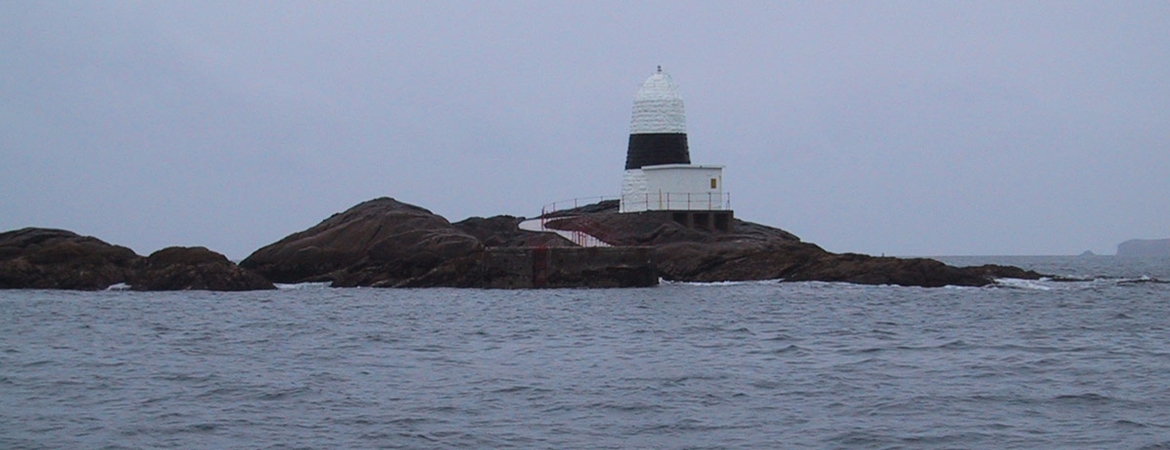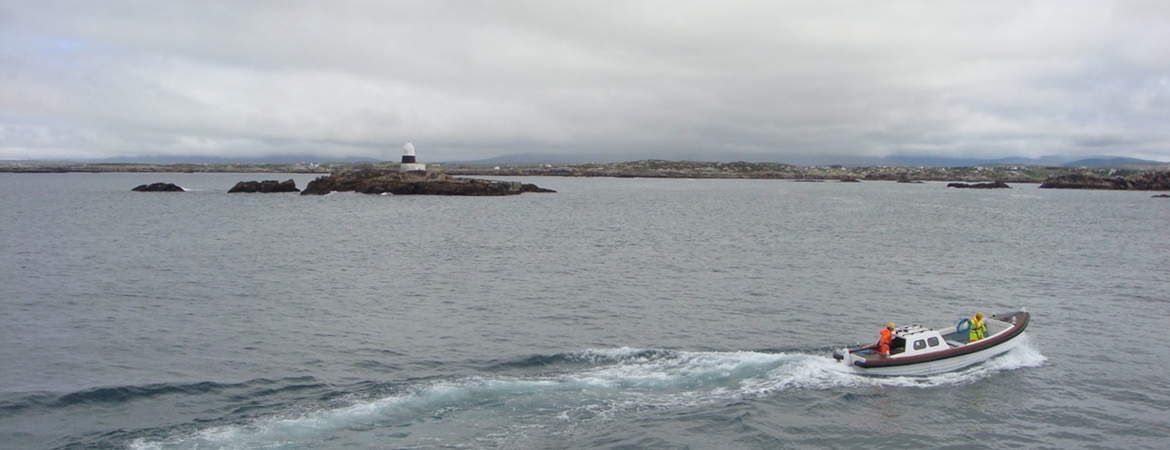Ballagh Rock or Carraig an Bealach, The Road Rock, is at the northern end of the channel of water between Aranmore Island and the Co Donegal mainland at Burtonport. The stretch of water is also known as the Aranmore Roads. Ballagh Rock is the largest of a group of rocks collectively called Blackrocks which are very exposed to seas especially from the north and north west.
A beacon on Ballagh Rock was recommended by the Inspecting Committee towards the end of June 1867; presumably after their Tour of Inspection. The Board ordered that a plan and estimate was to be prepared by the Inspector, Capt. E. F. Roberts and the Consultant Engineer, Mr C. P. Cotton.
Two months later Mr Cotton submitted his report which included plans of a beacon at an estimated cost of £350. The Board agreed that Trinity House and the Board of Trade should be informed.
In September 1867 approval for the beacon was received from both Trinity House and the Board of Trade. The latter gave their sanction to erect the beacon towards the end of October to which the Commissioners ordered that the job should be carried out.
Five and a half years later, in 1873, a Mr J. S. Charley, whom I have not been able to identify in relation to either Ballagh Rock or Irish Lights, requested that the works for erecting a stone beacon on Ballagh Rock should be commenced also mentioning that it was three (actually five) years since Board of Trade sanction had been received. The Board immediately ordered that tenders should be submitted for the beacon.
Soon after, in June, the Assistant Inspector, Captain E. H. Hawes, suggested purchasing a large buoy lying at Dundrum, Co. Down; adding it might be available for marking Ballagh Rock. The Engineer, Mr J. S. Sloane, was instructed to report and give a probable estimate of expense. Obviously it was not practicable and there was no further mention about it.
A revised estimate of expenditure of £450 was sanctioned by the Board of Trade in May 1874 and construction of the beacon went ahead in June and by July the beacon was 12 feet (3.6m) high.
Progress seemed to slow down for a period and Mr Charley agreed that little work had been done, up until December 1874, when questioned by the Commissioners over an incident involving a local Aranmore man and the Foreman of Works, Mr Cullen; this incident mellowed with time and no further reports were made.
Wintery weather must have held up progress but by May 1875 Mr Charley called the attention of the Board to push on with the Ballagh Rock Beacon works and a letter from Charley received in August 1875 testified to the substantial manner the beacon had been erected. He also requested that the beacon be painted white as the white-wash was already washed off, the Board agreed.
We can gather that the beacon was completed in 1875 and was considered by mariners to be of great assistance to navigation. The conical shaped stone beacon is approximately 15 feet (4.5m) diameter at the base and 30 feet (9.0m) high.
When the black band was added to the beacon is not certain but it was subsequent to 1926.
With the advent of the IALA Buoyage System "A", Blackrock as it had become to be known over the years, came into the second phase in 1981. One of the recommendations of the Inspecting Committee on Tour, 1979 was that Blackrock (Aranmore Roads) should be a lighted West Cardinal beacon. This presented an engineering problem insomuch that a West Cardinal character, nine quick flashes every fifteen seconds, could not be obtained with propane gas and using acetylene would involve heavy transport and possible delays, propane can always be obtained locally. The Engineer-in-Chief, Mr N. D. Clotworthy, suggested to the Inspector and Marine Superintendent, Captain H. N. Greenlee, in July 1980 that the light should be re-charactered as a lighthouse using easily obtainable propane. The Inspector agreed and suggested flashing white every 2.5 seconds and that the name be changed from Blackrock to Ballagh Rocks as there were already three other Blackrocks marked by the Service around the coast; Board's approval to the changes was sought and received on 29th August 1980.
Work went ahead in constructing a landing, a lean-to hut against the beacon for propane gas bottles and equipment, an access ladder to the lantern on top of the beacon and a path way from the landing to the beacon.
Early in June 1981 the contract Bolkow 105 helicopter, EI-BDI, ditched whilst conveying an underslung skip of contract for the landing, when flying between Arlands Point and Ballagh Rocks. Fortunately the pilot managed to get clear of the sinking helicopter and swam to nearby rocks where he was picked up by the attending boat which was at Ballagh Rocks and taken to Burtonport.
Due to the severe weather conditions that prevail, seemingly more often than not, the lantern could not be fitted to the top of the beacon until 1982, in spite of a Notice to Mariners being issued in July 1981 for August 24th. The light was eventually established on 21st May 1982 giving a one second white flash every two and a half seconds. The light source, supplied by AGA of Brentford is a GG 16 propane mantle in a 200mm diameter lantern.
Ballagh Rocks was converted to electric using batteries on the 1st May 1983.
A beacon on Ballagh Rock was recommended by the Inspecting Committee towards the end of June 1867; presumably after their Tour of Inspection. The Board ordered that a plan and estimate was to be prepared by the Inspector, Capt. E. F. Roberts and the Consultant Engineer, Mr C. P. Cotton.
Two months later Mr Cotton submitted his report which included plans of a beacon at an estimated cost of £350. The Board agreed that Trinity House and the Board of Trade should be informed.
In September 1867 approval for the beacon was received from both Trinity House and the Board of Trade. The latter gave their sanction to erect the beacon towards the end of October to which the Commissioners ordered that the job should be carried out.
Five and a half years later, in 1873, a Mr J. S. Charley, whom I have not been able to identify in relation to either Ballagh Rock or Irish Lights, requested that the works for erecting a stone beacon on Ballagh Rock should be commenced also mentioning that it was three (actually five) years since Board of Trade sanction had been received. The Board immediately ordered that tenders should be submitted for the beacon.
Soon after, in June, the Assistant Inspector, Captain E. H. Hawes, suggested purchasing a large buoy lying at Dundrum, Co. Down; adding it might be available for marking Ballagh Rock. The Engineer, Mr J. S. Sloane, was instructed to report and give a probable estimate of expense. Obviously it was not practicable and there was no further mention about it.
A revised estimate of expenditure of £450 was sanctioned by the Board of Trade in May 1874 and construction of the beacon went ahead in June and by July the beacon was 12 feet (3.6m) high.
Progress seemed to slow down for a period and Mr Charley agreed that little work had been done, up until December 1874, when questioned by the Commissioners over an incident involving a local Aranmore man and the Foreman of Works, Mr Cullen; this incident mellowed with time and no further reports were made.
Wintery weather must have held up progress but by May 1875 Mr Charley called the attention of the Board to push on with the Ballagh Rock Beacon works and a letter from Charley received in August 1875 testified to the substantial manner the beacon had been erected. He also requested that the beacon be painted white as the white-wash was already washed off, the Board agreed.
We can gather that the beacon was completed in 1875 and was considered by mariners to be of great assistance to navigation. The conical shaped stone beacon is approximately 15 feet (4.5m) diameter at the base and 30 feet (9.0m) high.
When the black band was added to the beacon is not certain but it was subsequent to 1926.
With the advent of the IALA Buoyage System "A", Blackrock as it had become to be known over the years, came into the second phase in 1981. One of the recommendations of the Inspecting Committee on Tour, 1979 was that Blackrock (Aranmore Roads) should be a lighted West Cardinal beacon. This presented an engineering problem insomuch that a West Cardinal character, nine quick flashes every fifteen seconds, could not be obtained with propane gas and using acetylene would involve heavy transport and possible delays, propane can always be obtained locally. The Engineer-in-Chief, Mr N. D. Clotworthy, suggested to the Inspector and Marine Superintendent, Captain H. N. Greenlee, in July 1980 that the light should be re-charactered as a lighthouse using easily obtainable propane. The Inspector agreed and suggested flashing white every 2.5 seconds and that the name be changed from Blackrock to Ballagh Rocks as there were already three other Blackrocks marked by the Service around the coast; Board's approval to the changes was sought and received on 29th August 1980.
Work went ahead in constructing a landing, a lean-to hut against the beacon for propane gas bottles and equipment, an access ladder to the lantern on top of the beacon and a path way from the landing to the beacon.
Early in June 1981 the contract Bolkow 105 helicopter, EI-BDI, ditched whilst conveying an underslung skip of contract for the landing, when flying between Arlands Point and Ballagh Rocks. Fortunately the pilot managed to get clear of the sinking helicopter and swam to nearby rocks where he was picked up by the attending boat which was at Ballagh Rocks and taken to Burtonport.
Due to the severe weather conditions that prevail, seemingly more often than not, the lantern could not be fitted to the top of the beacon until 1982, in spite of a Notice to Mariners being issued in July 1981 for August 24th. The light was eventually established on 21st May 1982 giving a one second white flash every two and a half seconds. The light source, supplied by AGA of Brentford is a GG 16 propane mantle in a 200mm diameter lantern.
Ballagh Rocks was converted to electric using batteries on the 1st May 1983.





